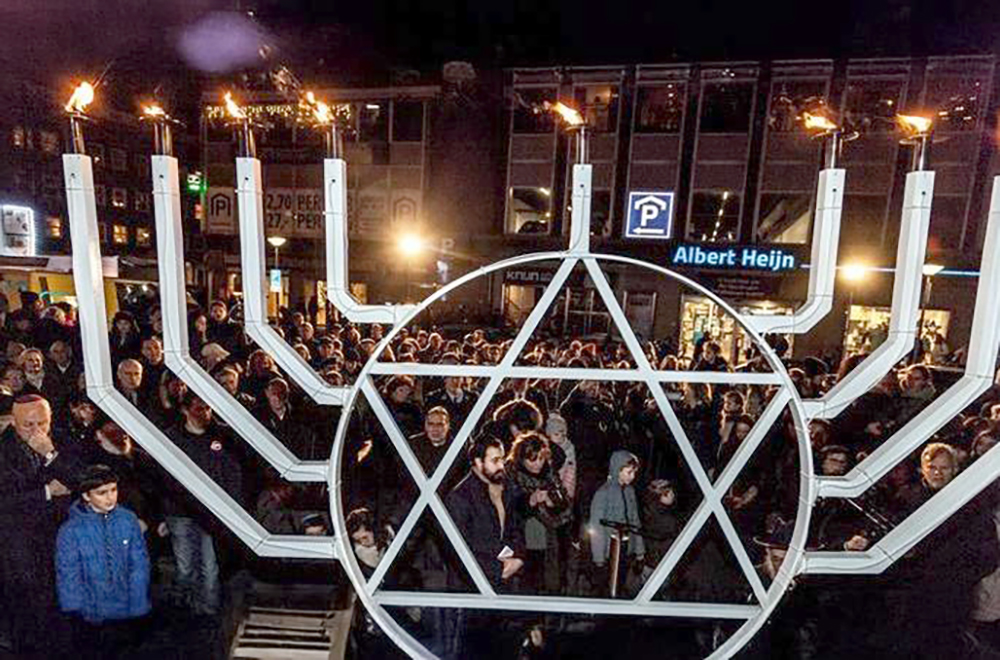|
Getting your Trinity Audio player ready...
|
By: Yehuda Altein
Amsterdam is now in the news as a place where Jews were brutally beaten. But did you know that the city boasts a rich Jewish history dating back over 400 years? A haven for Jews escaping religious persecution, Amsterdam became a center of Ashkenazi and Sephardi Jewish life whose influence was felt far and wide. Even after it was nearly snuffed out in the Holocaust, Jewish life has rebounded in this city of canals. Read on for 14 facts about Jewish Amsterdam’s prolific past and vibrant present.
- Jews Arrived There in the 16th Century
The story of Jewish Amsterdam begins in the 16th century. Amidst religious conflicts and intolerance across Europe, the Netherlands stood out as a rare sanctuary of religious freedom, attracting Jews from various countries who sought refuge from persecution. Many Sephardic Jews settled in Amsterdam, the country’s largest and most important city.
- It Was a Haven for Hidden Jews
In 1579, after breaking free from Spanish rule, the Netherlands offered a safe haven for Spanish and Portuguese conversos. These individuals, who had been forced to convert to Christianity, could now openly embrace their Jewish heritage without fear of the Inquisition.
- Eastern European Refugees Found a Home There
The mid-1600s brought another wave of Jewish refugees to Amsterdam, this time from Eastern Europe. These Ashkenazi Jews had fled violent Cossack-led attacks, often arriving in Amsterdam with little more than their lives. They were warmly welcomed by the local Sephardi community, who helped them rebuild their lives in the prosperous city.1
- Sephardim and Ashkenazim Thrived Side by Side
Amsterdam thus became home to both Sephardic and Ashkenazi Jews. Each group created its own institutions and appointed its own rabbis, and the two communities coexisted in harmony for centuries.
- Jews Enriched Amsterdam’s Economy
The 17th century marked the Dutch Golden Age, with Amsterdam becoming Western Europe’s wealthiest city, a hub for trade and finance. Jewish merchants, bankers, and entrepreneurs played an essential role in this prosperity, contributing significantly to commerce and even helping to finance the Dutch East and West India Companies.
- Great Rabbis Lived There
Amsterdam attracted notable rabbis who led its dual Jewish communities. Examples include Rabbi Menasseh ben Israel (1604–1657), a Portuguese former converso, who guided the Sephardic Jews, and Rabbi Tzvi Ashkenazi (1658–1718), known as the Chacham Tzvi, who led the Ashkenazi community. Other prominent figures included Rabbi Yitzchak Uziel (1550–1622), Rabbi Shaul Mortera (1596–1660), and Rabbi Elazar Rokeach (1685–1741), whose piety and scholarship made a lasting impression on Jewish Amsterdam.

- The Portuguese Synagogue Still Stands Today
In 1675, Amsterdam’s Sephardic community completed the magnificent Portuguese Synagogue, known locally as the Esnoga. Visiting Amsterdam in 1755, Rabbi Chaim Yosef David Azulai (the “Chida”) described it as the ideal synagogue—bright, spacious, and welcoming to all.2 It was the largest synagogue in the world at its completion, and the edifice has withstood the test of time—services are still held in its candle-lit sanctuary.
- It Was a Center of Hebrew Publishing
Amsterdam became a beacon of Hebrew publishing, with Rabbi Menasseh ben Israel establishing the city’s first Hebrew printing press in 1626. Over the next two centuries, Amsterdam publishers produced sacred texts of impeccable quality, spreading Torah learning far and wide.
- Its Wealth Was Used for Torah Study
Wealthy members of Amsterdam’s Jewish community supported Torah study both locally and abroad. Notable benefactors like Abraham and Isaac Pereira and David de Pinto funded yeshivahs (Jewish academies) in Jerusalem, Hebron, and Amsterdam. Ephraim Boeno, a physician, financed a new edition of the Code of Jewish Law. He urged Rabbi Moshe Rivkash, a renowned immigrant scholar from Lithuania, to enhance the Code with glosses and references, leading to the creation of the important work Be’er Hagolah.
- It Was Dubbed “Jerusalem of the West”
Amsterdam’s reputation for Jewish scholarship and its thriving community earned it the title “Jerusalem of the West,” highlighting its far-reaching influence across Western Europe and beyond.
- New Amsterdam Was Not as Welcoming
In 1654, Jews arrived in New Amsterdam (modern-day New York), then a Dutch colony. Ironically, while Jews enjoyed equal rights in Amsterdam, the New Amsterdam governor, Peter Stuyvesant, attempted to expel them. Only thanks to the efforts of the Dutch West India Company were his attempts rebuffed. Despite the rough start, New York ultimately developed into what is now the largest Jewish community outside of Israel.

- Mesilat Yesharim Was Written There
In 1734, Rabbi Moshe Chaim Luzzato (the “Ramchal”), a young Italian scholar and kabbalist, settled in Amsterdam, where he authored his classic work, Mesilat Yesharim (“Path of the Upright”), a guide to ethical living that remains a staple of Jewish study.
- It Was Anne Frank’s Home
When Nazi Germany occupied the Netherlands in 1940, the Amsterdam Jewish community faced devastation. Over 60,000 of the city’s 80,000 Jews were murdered during the Holocaust. Among them was 15-year-old Anne Frank, deported to Auschwitz after the family’s secret annex was discovered by the Gestapo.

- Jewish Life in Amsterdam Endures
Though the Holocaust severely impacted the Jewish community in Amsterdam, Jewish life has since been revived. Today, the city is home to a vibrant Jewish community with active synagogues, schools, kosher restaurants, and number of Chabad centers, which have served Amsterdam since 1964.
Rabbi Yehuda Altein is a writer, translator and editor specializing in Jewish subjects and handwritten family material. A former researcher for JLI’s Machon Shmuel Research Institute, he has written on Jewish history, scriptural exegesis, halachah, and chassidut. Yehuda resides in Brooklyn, N.Y., with his family and enjoys collecting antique Judaica and exploring natural history in the Torah.





